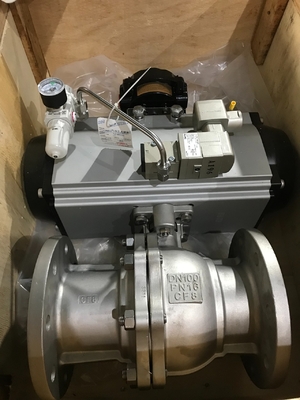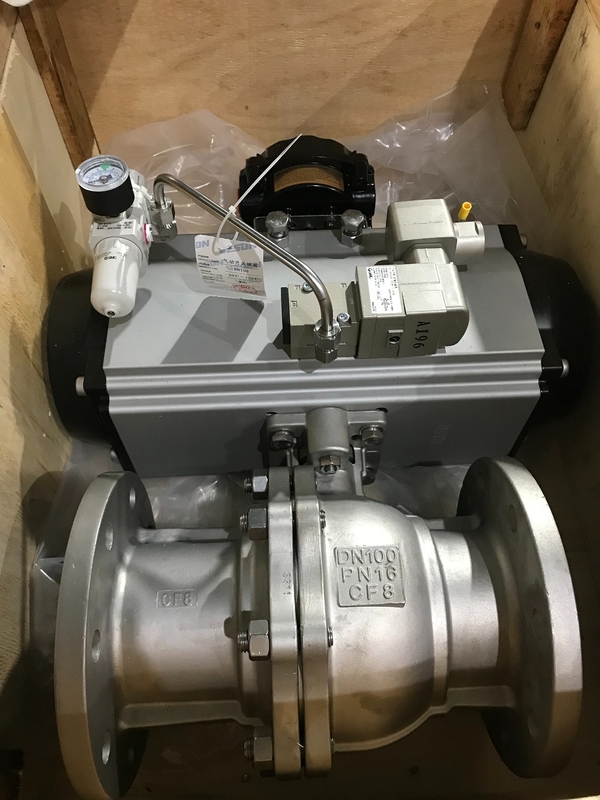2 Way On Off Ball Valve Flange end With Pneumatic Actuator
Product Details:
| Place of Origin: | China |
| Brand Name: | Veson/OEM |
| Certification: | ISO/CE/SIL3 |
| Model Number: | VS-083DA |
Payment & Shipping Terms:
| Minimum Order Quantity: | 1 Ea |
|---|---|
| Price: | FOB Shanghai |
| Packaging Details: | Carton/Plywood case |
| Delivery Time: | One week |
| Payment Terms: | L/C, T/T, Western Union |
| Supply Ability: | 10000PCS/Month |
|
Detail Information |
|||
| Power: | Air Pressure | Life Time: | One Million Time |
|---|---|---|---|
| Certifications: | CE, ATEX | Body Material: | Aluminum Alloy |
| Application: | Industrial Automation | Valve: | Pneumatic Piston Actuator |
| Function: | Quarter Turn Actuator | Type: | Pneumatic Actuator |
| Highlight: | 2 Way Ball Valve,Flange end Ball Valve,Pneumatic Actuator Ball Valve |
||
Product Description
![]()
![]() A 2-Way On/Off Ball Valve with a Flange End and Pneumatic Actuator is an industrial device used for controlling the flow of fluids, such as gases, liquids, or slurries, through a pipeline. Here’s a detailed breakdown:
A 2-Way On/Off Ball Valve with a Flange End and Pneumatic Actuator is an industrial device used for controlling the flow of fluids, such as gases, liquids, or slurries, through a pipeline. Here’s a detailed breakdown:
1. Ball Valve:
- 2-Way: Refers to the valve having two ports, an inlet, and an outlet, allowing fluid to flow in or out in one direction.
- On/Off Function: The valve can either allow flow ("On") or stop flow ("Off"). It’s a simple open/close mechanism.
- Ball Mechanism: Inside the valve, there is a spherical disc (ball) with a hole (bore) through its center. When the hole aligns with the pipe, fluid flows through; when it is turned 90 degrees, the flow stops.
- Flange End:
- Connection Type: The valve is connected to the piping system using flanges. Flanges are external ridges or lips (like a rim) around the circumference of the pipe that enable the valve to be bolted onto the pipeline.
- Advantages: Provides a secure, leak-proof connection and allows easy removal for maintenance.
2. Pneumatic Actuator:
- Function: The pneumatic actuator controls the movement of the ball valve. It converts compressed air energy into mechanical motion (rotational or linear) to open or close the valve.
- Types:
- Spring-Return (Single Acting): The actuator uses air to move in one direction, and a spring returns it to its original position when the air is released.
- Double Acting: Air is used for both opening and closing the valve, offering more precise control.
- Advantages: Pneumatic actuators are fast, reliable, and safe for use in hazardous environments where electrical actuation might be risky.
3. Applications:
- Industrial Automation: Common in automated systems for controlling the flow of various fluids.
- Process Industries: Used in chemical, pharmaceutical, food & beverage, water treatment, and oil & gas industries.
- Safety Systems: Often used in emergency shutdown systems due to their reliability and fast operation.
4. Material Considerations:
- Valve Body: Typically made from materials like stainless steel, carbon steel, or PVC, depending on the fluid and the operating environment.
- Seal Materials: Seals inside the valve are usually made from PTFE (Teflon), EPDM, or Viton, chosen based on the chemical compatibility and temperature requirements.
5. Control Options:
- Manual Override: Some pneumatic actuators come with a manual override, allowing the valve to be operated manually if needed.
- Position Indicators: Indicators show the valve's current position (open or closed) for monitoring purposes.
- Solenoid Valve: Often used with the pneumatic actuator to control the air supply, allowing remote operation
Want to Know more details about this product




